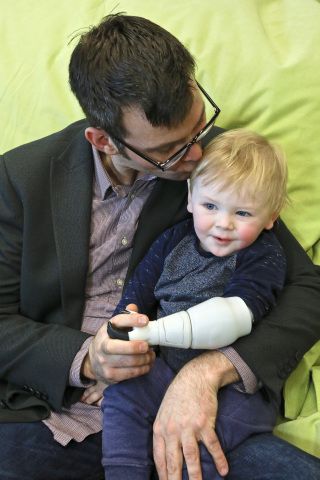
🦾 Part 1: A father who refused to give up and pioneered 3D prosthetics for children
Tragedy struck just 10 days into Sol's young life when complications dictated that his left arm would have to be amputated. The story of Ben Ryan and his company, Ambionics, is a powerful one of love, determination, innovation and perseverance.
Share this story!
In 2015, Ben was a psychology lecturer and new father to his son, Sol. Tragedy struck just 10 days into Sol's young life when complications dictated that his left arm would have to be amputated. It is difficult to imagine the emotions of a new parent, having to make such a difficult decision that would dramatically impact his son for the rest of his life.
Ben immediately looked into the treatment options for Sol and what kind of support they could expect. What he learned, he found to be unacceptable. Sol would have to wait three years for a myoelectric prosthetic from the U.K. National Health Services, or one year for a cosmetic, but non-functional prosthesis. As weeks crept on, Ben saw his son losing responsiveness in what remained of his left arm, and decided to take matters into his own hands.
Determined that no obstacle would stand in the way of his child living a full and active life, Ben set out to becoming a self-taught design engineer. He learned that, for some reason, many toddlers reject prosthetics early in life. After extensive research in infant development, Ben saw that higher rejection rates occur when children are fit after the age of two, and he began a race against the clock to develop a solution for Sol.
He began developing his idea for a replacement limb that was inspired by nature. Research taught him that spiders use fluid pressure to make their limbs move. Ben theorized that those same fluid-based movements could be applied to functioning prosthetics for humans.
In 2016, he set up a company called Ambionics with the singular goal of turning this thesis into a working reality. Researching infant development with prosthetics, they have developed a unique prosthetic for infants to wear, enabling a more natural acceptance of prosthetic arms for young children.
He designed and created his 3D printed hydraulic prosthetic arm for Sol which allowed him to move his robotic thumb on his own.
“The success of my patented DAHB mechanism draws on the advanced capabilities of the Stratasys Connex Printer – the ability to combine rigid and soft materials in a single print was vital to the success of the design,” explains Ben. “We were fortunate enough to have access to this technology, which enabled us to 3D print a prototype arm so quickly and cost-effectively. In founding Ambionics, it’s now my goal to ensure that other limb deficient children like my son are not faced with the current constraints and delays of traditional prosthetic manufacture.”

“This is a very innovative and ambitious project and it’s been inspiring to work with Ben on it,” says Paul Sohi, a product design expert at Autodesk. “It is amazing that despite Ben having no real background in product design, he’s effectively taught himself enough to create something that will not only help his own son Sol, but in Ambionics, potentially others facing the same challenges too.”
And help others he has. In part two of this article, coming later this week, we will learn the story of a young boy named Jacob Scrimshaw. A complete stranger to Ben Ryan, living in another part of the U.K., whose parents stumbled across the story of Ambionics while running a crowdfunding campaign to finance a functioning limb for their 5 year old son.
Want to get a dose of fact-based optimism in your mailbox once a week? Don't miss subscribing to our newsletter.
Warp News is run by the nonprofit Warp Institute, headquartered in Stockholm, Sweden and Raleigh, North Carolina, United States.
The world is better now than ever before!
But most people still have a negative view of the future. We think one important reason is the negative bias in news media. The fact is, negative news gets way more coverage than the positive.
Warp News balances that by delivering fact-based optimistic news.
By becoming a premium supporter, you help in the creation and sharing of fact-based optimistic news all over the world.


